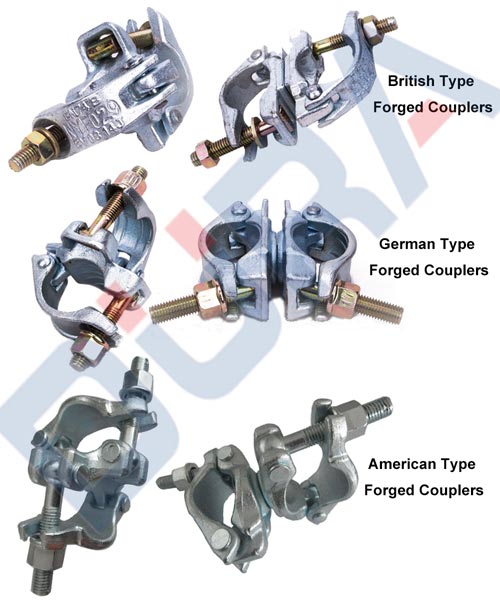Materials
Scaffolding materials include tubes couplers boards or decking.
Tubes are usually made either of steel or aluminum; although there is composite scaffolding which uses filament-wound tubes of glass fiber in a nylon or polyester matrix, because of the high cost of composite tube, it is usually only used when there is a risk from overhead electric cables that cannot be isolated. If steel, they are either ‘black’ or galvanized. The tubes come in a variety of lengths and a standard outside diameter of 48.3 mm. (1.5 NPS pipe). The chief difference between the two types of metal tubes is the lower weight of aluminum tubes (1.7 kg/m as opposed to 4.4 kg/m). However, they are more flexible and have a lower resistance to stress. Tubes are generally bought in 6.3 m lengths and can then be cut down to certain typical sizes. Most large companies will brand their tubes with their name and address to deter theft.
Boards provide a working surface for scaffold users. They are seasoned wood and come in three thicknesses (38 mm (usual), 50 mm and 63 mm) are a standard width (225 mm) and are a maximum of 3.9 m long. The board ends are protected either by metal plates called hoop irons or sometimes nail plates, which often have the company name stamped into them. As well as timber, steel or aluminum decking is used, as well as laminate boards. In addition to the boards for the working platform, there are sole boards which are placed beneath the scaffolding if the surface is soft or otherwise suspect, although ordinary boards can also be used. Another solution, called a Scaff pad, is made from a rubber base with a base plate molded inside; these are desirable for use on uneven ground since they adapt, whereas sole boards may split and have to be replaced. A short section of steel scaffold tube.
Couplers are the fittings which hold the tubes together. The most common are called scaffold couplers, and there are three basic types: right-angle couplers, putlog couplers and swivel couplers. To join tubes end-to-end joint pins (also called spigots) or sleeve couplers are used. Only right-angle couplers and swivel couplers can be used to fix tube in a ‘load-bearing connection’. Single couplers are not load-bearing couplers and have no design capacity.

Other common scaffolding components include base plates, ladders, ropes, anchor ties, reveal ties, gin wheels, sheeting, etc. Most companies will adopt a specific color to paint the scaffolding with, in order that quick visual identification can be made in case of theft. All components that are made from metal can be painted but items that are wooden should never be painted as this could hide defects. Despite the metric measurements given, many scaffolders measure tubes and boards in imperial units, with tubes from 21 feet down and boards from 13 ft down.
What materials can be used to increase the working level height of employees on supported scaffolds? Stilts may be used on a large area scaffold. When a guardrail system is used, the guardrail height must be increased in height equal to the height of the stilts. The manufacturer must approve any alterations to the stilts. Note: A large area scaffold consists of a pole, tube and coupler systems, or a fabricated frame scaffold erected over substantially the entire work area.
